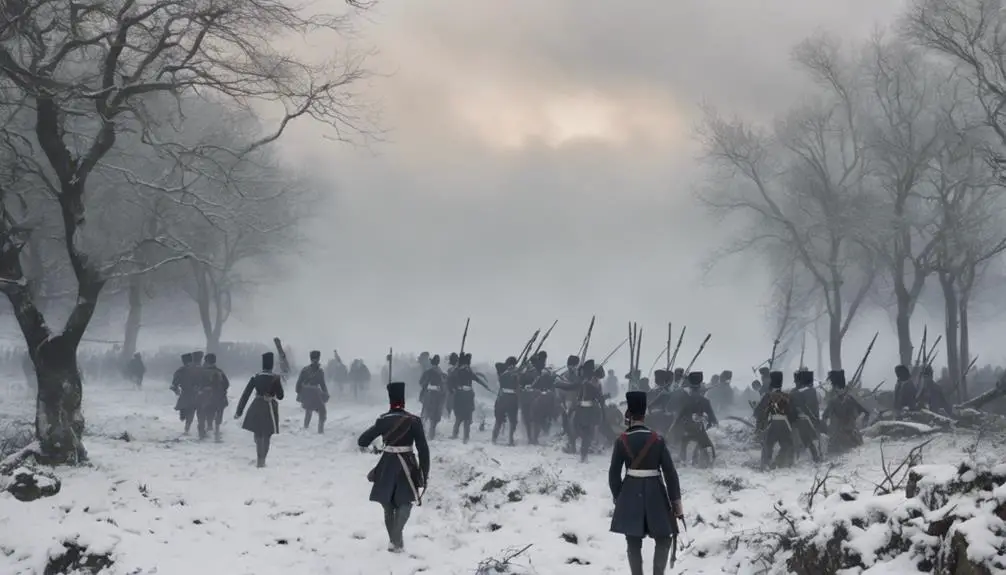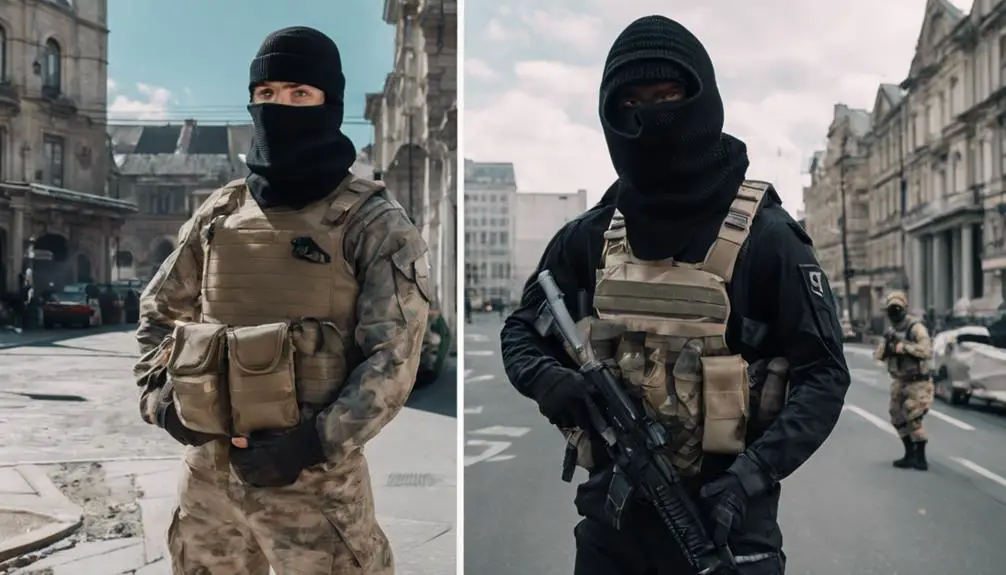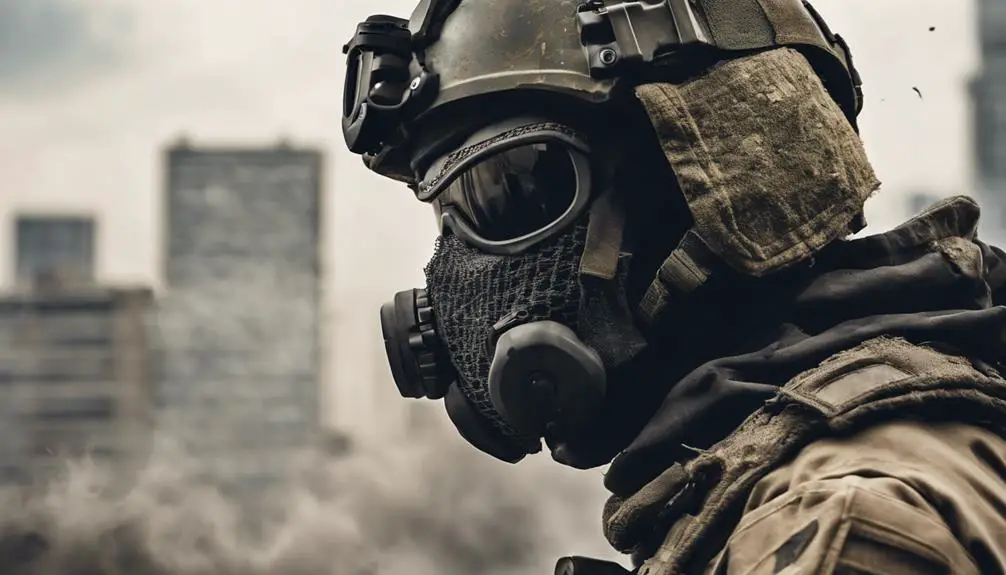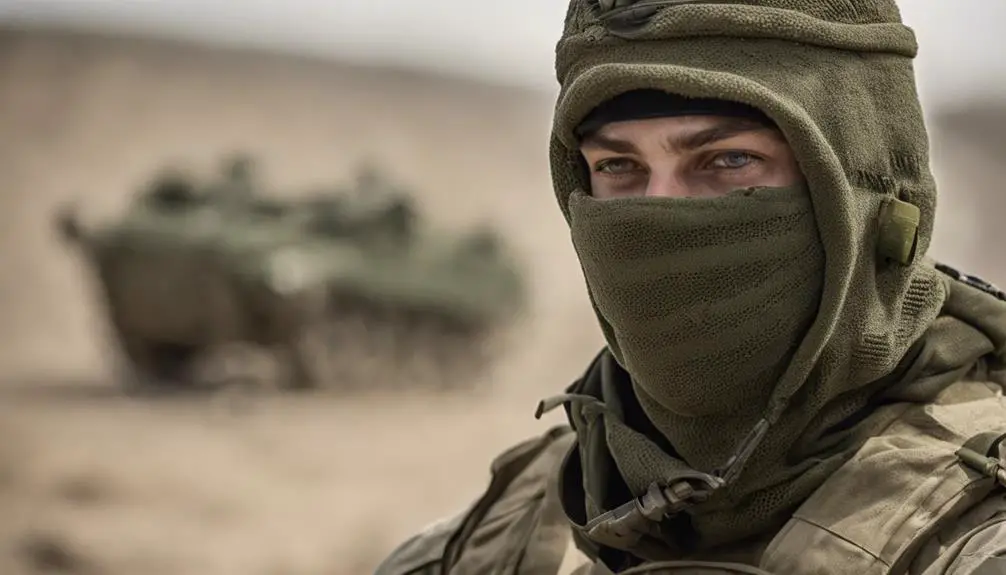You're likely familiar with the term 'balaclava' as a winter accessory, but its origins date back to the Crimean War and the infamous Battle of Balaclava. The name 'balaclava' comes from the town where British soldiers wore a special helmet to combat harsh winter conditions. Today, the term has evolved to encompass a range of styles and materials. But did you know that its military roots run deeper? The balaclava has become an essential component of combat attire, providing protection and anonymity in covert operations. As you explore its history, you'll uncover more surprising connections between military garb and modern fashion.
Origins of the Balaclava Term

Deriving from the name of a key 19th-century battle, the term 'balaclava' has a rich history that dates back to the Crimean War. You might be wondering, what's the connection between a piece of headgear and a 19th-century conflict?
Well, it all started during the harsh Crimean Winter of 1854. The British Expedition, led by Lord Raglan, was struggling to cope with the freezing temperatures and lack of supplies. To keep warm, British soldiers wore a type of headgear that covered their heads, necks, and faces, leaving only their eyes visible. This innovative piece of clothing was dubbed the 'balaclava helmet' after the town of Balaclava, which played a significant role in the war.
As the war drew to a close, the term 'balaclava' became synonymous with this type of headgear. You might be surprised to learn that the balaclava wasn't just a British invention; it was also worn by Russian soldiers during the war.
The term stuck, and today, the balaclava is an essential part of military attire worldwide. Its origins may be rooted in the Crimean War, but its significance extends far beyond that conflict.
The Battle of Balaclava Explained
As you explore the origins of the balaclava, it's natural to wonder about the pivotal battle that inspired its name, and the events of October 25, 1854, are a fascinating case study in military strategy and chaos.
The Battle of Balaclava, fought during the Crimean War, was a series of missteps and misunderstandings that led to one of the most infamous military blunders in history. The Charge Fiasco, as it came to be known, was a catastrophic mistake that resulted in the decimation of the British cavalry.
You'll notice that the events of that fateful day are a masterclass in how not to conduct warfare. The cavalry, led by Lord Raglan, received ambiguous orders, which led to a series of miscommunications and ultimately, a disastrous charge into the jaws of the Russian artillery.
The cavalry blunders that day were a demonstration of the importance of clear communication and sound decision-making in the heat of battle. As you explore further into the story, you'll realize that the Battle of Balaclava serves as a cautionary tale about the importance of military strategy and the devastating consequences of mistakes on the battlefield.
From Fashion to Military Gear

You're likely familiar with the balaclava as a fashionable winter accessory, but its origins are rooted in military necessity, with the British army adopting it as an essential piece of gear during the Crimean War.
As you explore the history of the balaclava, you'll discover that its evolution from military gear to fashion trend is a fascinating one. Initially, the balaclava served as a practical solution for soldiers to keep warm in harsh winter conditions. However, as outdoor enthusiasts adopted the balaclava for their own adventures, its popularity grew, and it eventually became a staple in fashion trends.
Today, you can find balaclavas in a variety of styles, materials, and colors, catering to both functional and fashionable needs. Whether you're an avid hiker or a fashion-conscious individual, the balaclava has become an essential accessory for many. Its transformation from military gear to fashion must-have is a demonstration of the power of innovation and adaptation.
The Rise of Military Jargon
Military slang, born from the trenches of war, has permeated modern language, with terms like 'buddy' and 'chopper' becoming an integral part of our everyday vocabulary. As you investigate the world of military jargon, you'll discover that it's not just a language, but a cultural phenomenon. The rise of military slang can be attributed to the Lingo Revival, where soldiers created code-like phrases to communicate secretly during wartime. This Code Cracking mentality has been adopted in modern times, with military slang becoming a staple in popular culture.
| Term | Origin | Meaning |
|---|---|---|
| Buddy | WWI | Friend or comrade |
| Chopper | Vietnam War | Helicopter |
| Foxhole | WWI | Trench or dugout |
| Roger That | WWII | Affirmative response |
| Sitrep | WWII | Situation report |
The table above highlights just a few examples of military slang that have become an integral part of our language. As you explore the world of military jargon, you'll realize that it's not just about the words, but the history and culture behind them.
Balaclava in Modern Warfare

In modern warfare, the balaclava has evolved from a fundamental headgear to an essential component of combat attire, providing protection from the elements and anonymity in covert operations.
You're likely to find it in the gear of special operations forces, who rely on it to gain a tactical advantage in stealth operations. The balaclava's ability to conceal your identity allows you to blend in with the environment, making it an indispensable tool for reconnaissance and sabotage missions.
In urban warfare, it helps you merge with the crowd, reducing the risk of detection. Additionally, the balaclava's warmth and protection from the elements make it a must-have in extreme climates. When you're operating in harsh environments, the last thing you need is to be distracted by the cold or wind.
The balaclava ensures you can focus on the mission at hand, giving you a critical edge in high-stakes situations. By providing both physical and tactical benefits, the balaclava has become an indispensable component of modern combat gear.
Evolution of Military Headgear
From ancient Greece to modern warfare, headgear has undergone a notable transformation, with each era introducing innovative designs that cater to the evolving needs of combatants. You've seen how headgear has adapted to new materials, technologies, and combat scenarios. Let's break down this evolution:
| Era | Headgear Innovations |
|---|---|
| Ancient Greece/Rome | Leather helmets, bronze helmets |
| World War I/II | Steel helmets, gas masks |
| Modern Warfare | Composite materials, advanced padding |
As you can see, headgear innovations have been driven by the need for better protection, comfort, and functionality. Helmet materials have shifted from leather and bronze to steel and, more recently, advanced composites. These advancements have greatly improved the safety and effectiveness of combatants. Today, headgear designs continue to evolve, incorporating cutting-edge materials and technologies to meet the demands of modern warfare. By understanding the evolution of military headgear, you'll appreciate the importance of innovative designs in supporting combatants on the battlefield.
Frequently Asked Questions
Are Balaclavas Only Used for Military Purposes?
You might think balaclavas are only for military use, but that's not the case. Historically, they've been a fashion statement, symbolizing rebellion or nonconformity. Think 19th-century anarchists or 20th-century punk rockers.
Today, you'll find balaclavas in high-fashion collections, adding a touch of edginess to runway models. Their historical significance extends beyond military contexts, representing a fusion of style and subculture.
Can Anyone Wear a Balaclava in Public?
You're like a canvas, and your outfit is the artwork – every piece matters.
When it comes to wearing a balaclava in public, you might be making a fashion statement, but you're also subject to public perception.
While some might view it as edgy or stylish, others might see it as suspicious or intimidating.
Ultimately, it's up to you to decide whether the statement is worth the potential scrutiny.
Are Balaclavas Warm Enough for Extreme Cold?
You're wondering if balaclavas are warm enough for extreme cold. The answer lies in their Cold Resistance and Thermal Performance.
A good balaclava should retain body heat while allowing moisture to escape, ensuring your head and neck stay warm. Look for materials with high thermal insulation, like fleece or wool, and a snug fit to prevent cold air from seeping in.
With the right design and materials, a balaclava can be a reliable cold-weather companion.
Can Balaclavas Be Worn With Helmets?
Did you know that 75% of outdoor enthusiasts prioritize helmet compatibility when choosing cold-weather gear?
When it comes to wearing balaclavas with helmets, you'll be relieved to know that most modern designs accommodate this combination. The key is to guarantee a snug, comfortable fit.
Look for balaclavas with a slim profile and breathable materials to maximize the comfort factor. By doing so, you'll enjoy a seamless, warm, and safe outdoor experience.
Are Balaclavas Effective Against Chemical Attacks?
When facing a chemical threat, you need protection you can rely on.
In this scenario, you're wondering if balaclavas are effective against chemical attacks. The answer lies in their filter efficiency. Against toxic gas, a balaclava with a high filter efficiency can provide some protection.
However, it's important to emphasize that they're not a substitute for a gas mask. In a high-risk situation, it's vital to wear a mask with a high filter efficiency to guarantee your safety.
Conclusion
As you peel back the layers of military slang, the balaclava's significance unfolds like a rich tapestry. From the Crimean War's bloody battlefields to modern warfare's high-tech trenches, this humble headgear has evolved, adapting to the rhythms of conflict.
Like a chameleon, it has shed its fashionable skin to don the mantle of utility, silently witnessing the ebb and flow of human conflict. Today, the balaclava stands as a symbol of war's relentless drive for innovation, a reflection of humanity's unyielding quest for survival.







